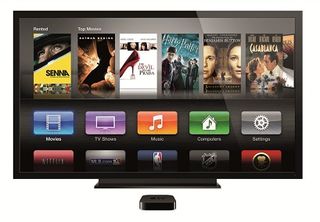Apple Raises Stakes With 4G High-Res iPad, Upgrades Set-Top
Hoping to hold the lead in the category it pioneered, Apple introduced the next-generation iPad tablet, which features an ultra-high-resolution screen capable of displaying Blu-Ray-quality video and support for high-speed LTE wireless networks.
Apple, at a press conference Wednesday in San Francisco, also showed off a new version of the $99 Apple TV set-top box. The box has a redesigned interface and support for 1080p high-definition video. Movies and TV show sold through iTunes will be available in the higher-quality format, according to Apple execs.
The next-generation iPad is priced at $499 for 16 Gigabytes of storage; $599 for 32 GB; and $699 for 64 GB. The 4G wireless models will run an extra $130 on top of those prices.

Both the iPad and the enhanced Apple TV are set to be available March 16.
"Apple has its feet firmly planted in the post-PC future," Apple CEO Tim Cook said in introducing the new tablet.
The new iPad has the same 9.7-inch screen size as its predecessors but has a "Retina" 2048-by-1536 display for a pixel depth of 3.1 million, four times the resolution of the original iPad and iPad 2 -- and 1 million more pixels than a 1080p HDTV, according to Apple.
For the TV industry, when the iPad debuted in mid-2010, it quickly became a killer video viewing device. Through the end of last year, Apple had sold 55 million of the devices, including 15.4 million iPads in the fourth quarter of 2011 alone.
Multichannel Newsletter
The smarter way to stay on top of the multichannel video marketplace. Sign up below.
The crisper, higher-resolution screen -- capable of displaying 1080p HD, equivalent to Blu-ray Disc video quality -- should increase the iPad's value as a video-consumption gadget.
The first iPad, released in April 2010, had a 9.7-inch 1024-by-768 pixel display featuring 130 pixels per inch. The iPad 2 featured a thinner, lighter display but with the same resolution.
The new 1.4-pound iPad -- Apple is dispensing with using a number in the product name with the third-generation tablet -- also includes a 5-megapixel camera, with the ability to record video in 1080p format.
The latest iPad's support for 4G LTE should help drive adoption of Verizon Wireless's and AT&T's LTE services, which offer connection speeds up to 10 times as fast as 3G data networks. It can act as a hotspot for up to five Wi-Fi devices. The 4G tablet also will be available from Canada's Rogers Communications, Bell and Telus.
Pay TV operators have tried to capitalize on the iPad's surging success. Comcast, Time Warner Cable, DirecTV, Cox Communications, Cablevision Systems and others have launched iPad apps for viewing live and on-demand TV content on the tablets.
Dozens of cable programmers and broadcasters have developed apps for the device to let consumers view and discover content, share via social networks and otherwise engage with TV content.

Other consumer electronics manufacturers have tried to copy the iPad's success -- including Motorola Mobility, Amazon.com, Barnes & Noble, Samsung Electronics and Sony -- but so far none of the challengers has come close to the iPad's popularity.
However, tablets based on Google's Android operating system are closing the gap. In the fourth quarter of 2011, Android-based tablets had 39% of the market (up from 29% a year earlier), while the iPad dropped to 58% from 68%, according to research firm Strategy Analytics.
Apple said that more than 25 billion apps have been downloaded from its App Store by more than more than 315 million iPhone, iPad and iPod touch users worldwide. The iTunes App Store now offers 585,000 apps for the devices, including more than 200,000 native iPad apps, Apple said.
With strong sales expected for the higher-resolution iPad, Apple in 2012 is projected to nearly double its spending on displays used in media tablets and smartphones to $9 billion, according to IHS iSuppli Display Materials & Systems Service research. Apple's suppliers for the iPad include LG Display, Samsung Display and Taiwanese-based ChiMei Innolux.
Apple is keeping the iPad 2, but knocking $100 off the price. The Wi-Fi-only iPad 2 with 16 GB of storage will be $399, while the 3G model with 16 GB will be $529.
Meanwhile, the new Apple TV interface, which is designed to make it easier to access content purchased from iTunes and from third-party services, is available immediately to users of the second-generation set-top via a free software update. But the new Apple TV model is required to play 1080p video.
The latest Apple TV also supports iCloud, letting users access iTunes content purchased on any other device directly on the TV. The AirPlay Mirroring feature lets iPhone 4S and iPad users stream whatever is on their screens, including Web pages and games, to the Apple TV.
Also Wednesday, Netflix said it had expanded its deal with Apple to let Apple TV users sign up for the video-streaming service directly and pay via their iTunes accounts.
